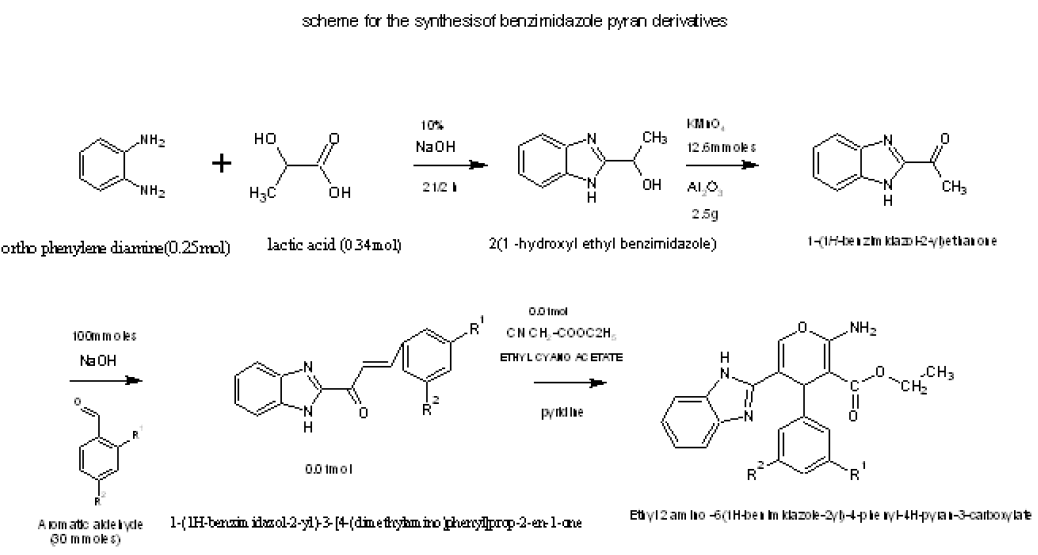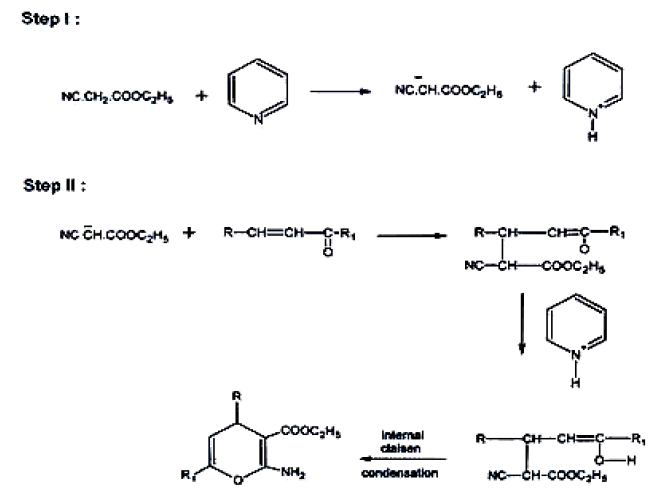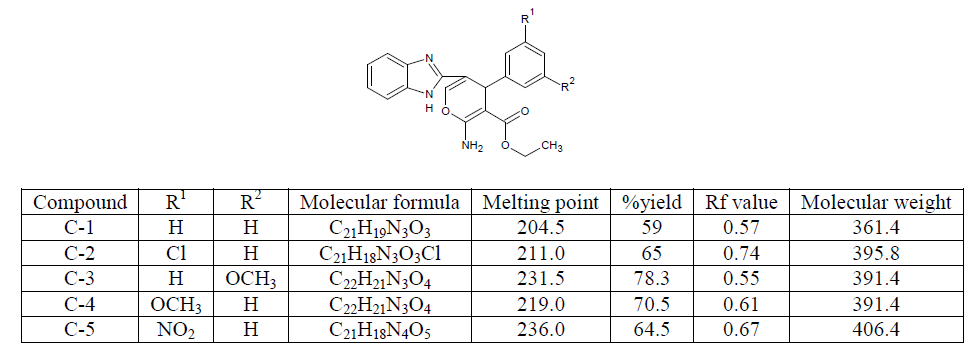Research Article - (2011) Volume 1, Issue 2
1Sri Ramakrishna College of Pharmacy, SRIPMS, Coimbatore, Tamilnadu, India
2Chemists College of Pharmaceutical Sciences and Research, Varikoli, Ernakulum, Kerala, India
3Crescent College of Pharmaceutical Sciences, Madayipara, Kannur, Kerala, India
In continuation of our research for new antitubercular agents, a series of substituted benzimidazoles with pyran were synthesized and screened for their anti tubercular activity by Alamar Blue assay method. The structure and purity of all the compounds were confirmed on the basis of chromatographic data, elemental analysis and spectral studies. All the synthesized compounds were found to be active against Mycobacterium tuberculosis H37Rv at 10 and 100 mcg/ml concentrations. But the compounds C-1, C-3, and C-5 showed effective antitubercular activity, even at 1mcg/ml concentration. The 2-methoxy phenyl derivative exhibited better anti tubercular activity compared to the 4-methoxy phenyl compound. Molecular docking studies were also done subsequently, using target, enoyl reductase enzyme (InhA) to find the structural requirement for activity for these series of compounds.
Tuberculosis remains one of the deadliest threats to public health .Every year two million people die of tuberculosis, caused by Mycobacterium tuberculosis. Roughly one third of the world’s population is infected and more and more bacterial strains have developed resistance to drugs. M. tuberculosis is dangerous as it hides and persists in the immune cells of our bodies. However this problem has become serious as M. tuberculosis developed resistance against both the first line and also the second line of drugs. Due to this, there is an emergence of multi drug resistance (MDR) and extensively drug resistant (XDR) strains of M.tuberculosis all over the world including India. The increasing incidence of MDR and XDR tuberculosis worldwide highlight the urgent need to search for newer anti tuberculosis drugs.
Benzimidazole [18] nucleus is a constituent of many bioactive heterocyclic compounds that are of wide interest because of their diverse biological and clinical applications [14,15,16,17].
Moreover, benzimidazole derivatives are structural isosters of naturally occurring nucleotides [23,24], which allows them to interact easily with the biopolymers of the living system .This created interest in researchers who have synthesized varitty of benzimidazole derivatives and screened for their antimicrobial [9,10,19], antisecretory [20], anticancer [6,27], antiHIV [28], antihypertensive [26], antitumor [31], anthelmintic [7,8], antidiabetic [39], antioxidant [29,30], antifungal [11], analgesic [32] & anti inflammatory [33] and anti protozoal [25] activities.
Being an airborne disease with no vaccine, it is the single largest disease encountered by both developing and developed countries. Such factors forced the scientists across the globe to search for newer molecules that can be used as lead compounds for the development of newer anti tubercular drugs with better therapeutic effects.
The benzo derivatives of imidazole or imidazoline are termed as benzimidazole. Benzimidazole belonging to the fused hetercyclic system prepared from amino acids is associated with diverse pharmaceutical activities. The most prominent benzimidazole compound in nature is N-ribosyl – dimethyl benzimidazole which serves as an axial ligand for cobalt in vitamin B12 [21]. Reports [22] indicated that substitution on pyridine by electron donating groups, increase the activity.
Hansa Parekh et al [1] synthesized 3-(5l benzoyl –benzimidazole -2l yl-benzamido-phenyl) 5-aryl isoxazoles and observed 90% inhibition of M.tuberculosis at lower concentrations. A.S.Gupta etal [2] reported the anti tubercular activity of 3-amino (N-aryl –substituted)-6-bromo-2H-1- benzopyran -2-one and 6-bromo-3-phenoxy -2H-1-benzopyran-2-ones. M.ShaharYar etal [3] reported the antitubercular activity of 2-(5-(4-flurophenyl) -1-phenyl -4,5-dihydro –H-3- pyrazolyl)-1H-benzimidazole against M.tuberculosis H37RV. Kamlesh. V et al [4] reported about the strong anti microbial activity of 1-(4 carboxy-3-hydroxy phenyl amino methyl) benzimidazole transition metal complexes. Vijaya.B.Reddy etal [5] reported the antitubercular activity of a series of 2-substituted phenoxy methyl benzimidazole and 1-alkyl 1-2 substituted phenoxy methyl benzimidazole.
Among the hundreds of benzimidazole derivatives tested, the most therapeutically useful modifications were on the 2nd or 5th position of the ring system [35,36,37]. Similarly pyrans and their derivatives posses anti bacterial [13], anti tubercular [2] and anti fungal [12] activities.
Hence in the present work we have decided to explore the therapeutic advantages of pyran moiety in combination with benzimidazole.
Drug discovery and development is a research process where a new chemical entity is recognized and developed by designing and screening against proper biochemical target. This process is an expensive, complicated, and time consuming schedule in its conventional pattern. A huge breakthrough in the process of drug design was the development of Insilco method to predict about the therapeutic efficacy of the molecule. In our present study, some possible derivatives of benzimidazole pyran compounds were proposed and docked by using Enoyl reductase enzyme (InhA) (Protein Data Bank id 2H7L) and insilco molecular study of these analogues were done, and observed that, all these compounds obeyed “Lipinski rule of five”. We used Autodock 4.2, Cygwin and Accelerys discovery studio programmes to predict the anti mycobacterial activity for the derivatives selected. The molecular properties of the compounds selected were evaluated by the online server Molinspiration.
All the chemicals were obtained from S.D.Fine Chem. and Loba Cheme and the substituted ketones from Himedia and ethanol from Hayman Ltd. Melting points of all the synthesized compounds were determined using melting point apparatus MP-DS, TID 2000 and were uncorrected. The UV and IR spectra of the compounds were recorded on JASCO V 530 UV/VIS spectrophotometer, JASCO FT/IR-410 respectively, at the Dept.of Pharmaceutical analysis, SRIPMS, Coimbatore, India. The Mass spectra of the compounds were recorded on Finnegan MAT 8230 at Indian Institute of Technology, Chennai. The PMR spectra of the compounds were recorded on Burker 200 MHz at the Dept. of Chemistry, Bharathidasan University, Trichy.
Scheme of synthesis -1
Step-1
Synthesis of 2-(α-hydroxyl ethyl) benzimidazole: A mixture of 27 g (0.25mol) of o-phenylene diamine, 25.5ml (30.6g, 0.34 mol) of lactic acid was refluxed for 2½ hours. Reaction mixture was cooled and made alkaline by the gradual addition of 10% sodium hydroxide solution .The crude product obtained was dissolved in 400 mi of boiling water. To this 2 g of activated charcoal was added and digested for 15 min.
The digested solution was filtered rapidly at the pump through a pre heated Buchner funnel, the filtrate was cooled to about 10°C.The product obtained was filtered and washed with 25 mi of cold water and dried at 100 °C.
Step-2
Synthesis of 2-acetyl benzimidazole: The alumina supported permanganate was prepared by mixing KMnO4 (2g, 12.65 mmoles) and solid neutral alumina (2.5 g) in a mortar and ground with a pestle until a homogenous purple powder was obtained. The compound obtained from step -1 (5 mmoles) was added to the above mixture and ground with a pestle at room temperature for another 5 min. Acetone (20ml) was added to the reaction mixture and after vigorous stirring the mixture was filtered and the acetone filtrate was evaporated to obtain a crude residue, and taken up in chloroform (15ml) and washed with water (30ml) to remove any inorganic matter and dried over anhydrous sodium sulfate. The crude product obtained was recrystalised from hot water to get pure needle like crystals.
Step-3
Synthesis of chalcones according to Claisen-Schmidt condensation [34]: Sodium hydroxide pellets (4 g, 100mmoles) and the compound obtained from step-2 (20 mmoles) were ground in a mortar to a fine powder at room temperature. To this different aromatic aldehydes (30mmoles) were added and the mixture was ground by pestle at room temperature for a few minutes till the condensation was completed. The solid mixture was suspended in water to remove inorganic impurities and filtered .The residue was washed with water and dried.
Step-4
Synthesis of pyrans: The mixture of chalcones (0.01mole) and ethyl cyano acetate (0.01mol) in pyridine was refluxed for 48h, cooled and poured in to water. The solid residue thus obtained was filtered and recrystalised from chloroform-petroleum ether mixture (1:2)

Scheme 2
The reaction [38] of chalcones with ethyl cyanoacetate ring system


Compound -1
C21H19N3O3, m.p.:204-205°C, UVλmax (EtOH):299nm ; Rf value: 0.57 (Benzene: Ethanol; 1:2, development: iodine reagent); I.R (KBr):3242cm-1 [NH stretching], 1629 cm-1 [C=O stretching], 1445.39 cm-1 [ring C=C stretching], 884.02 cm-1 [CN stretching]; M/e: 361.4, 118(48%), 131(30%), 77(28%). ; Elemental analysis: for C21H19N3O3, Calculated: C=69.8%, H=5.3%, N=11.6%, O=13.3% , Found: C=69.5%, H=5.0%, N=11.4%, O=13.0%
Compound-2 C21H18N3O3Cl, m.p.:210-2120C, UVλmax (EtOH):301nm ; Rf value: 0.74 (Benzene: Ethanol; 1:2, development: iodine reagent) ; I.R(KBr) :3242cm-1 [NH stretching],1629 cm-1 [C=O stretching], 1445.39 cm-1 [ ring C=C stretching ], 884.02 cm-1 [CN stretching], 748 cm-1[C-Cl stretching].; M/e: 395.8, 118, 131, 112, 77. ; Elemental analysis: for C21H19N3O3, Calculated: C=63.66%, H=4.5%, N=17.4%, O=12.15 % Found: C=63.5%, H=3.8%, N=16.7%, O=11.56%
Compound-3
C22H21N3O4, m.p.:210-2120C, UVλmax (EtOH):303nm ; Rf value: 0.55 (Benzene: Ethanol; 1:2, development: iodine reagent); I.R (KBr):3242cm-1 [NH stretching], 2824 cm-1, 1629 cm-1 [C=O stretching], 1445.4 cm-1 [ring C=C stretching], 884.02 cm-1 [CN stretching], 748 cm-1[C-Cl stretching].; M/e: 391.4, 131,118, 108, 77. ; Elemental analysis: for C22H21N3O4, Calculated: C=67.45%, H=5.36%, N=13.03%, O=16.35 % Found: C=67.4%, H=5.25%, N=13.0%, O=16.24%
Compound-4
C22H21N3O4, m.p.:218-2200C, UVλmax (EtOH):301nm ; Rf value: 0.61 (Benzene: Ethanol; 1:2, development: iodine reagent); I.R (KBr):3242cm-1 [NH stretching], 2825 cm-1, 1629 cm-1 [C=O stretching], 1445.5 cm-1 [ring C=C stretching], 884.0 cm-1 [CN stretching]. ; M/e: 391.4, 131,118, 108, 77. ; Elemental analysis: for C22H21N3O4 Calculated: C=67.45%, H=5.36 %, N=13.03%, O=16.35 % , Found: C=67.4%, H=5.3 %, N=13.0%, O=16.25%
Compound -5
C21H18N4O5, m.p.:235-2370C, UVλmax (EtOH):306nm ; Rf value: 0.67 (Benzene: Ethanol; 1:2, development: iodine reagent.); I.R (KBr):3242cm-1 [NH stretching], 1629 cm-1 [C=O stretching], 1360cm-11445.5 cm-1 [ring C=C stretching], 884.0 cm-1 [CN stretching]; M/e: 361.4, 118(48%), 131(30%), 77(28%). ; Elemental analysis: for C21H19N3O3, Calculated: C= 62.0%, H=4.4%, N=16.75%, O=19.7%Found: C=61.5%, H=4.0%, N=16.45%, O=19.5%
Anti tubercular activity screening studies [40,41]
Alamar Blue Assay method: Alamar blue is an oxidation reduction dye used for screening anti tubercular activity. The oxidized form of alamar blue turns in to pink color upon reduction. Since M.tuberculosis is an aerobic organism its growth turns alamar blue to pink. This technique has been used to predict the presence or absence of growth of M.tuberculosis for testing anti microbial agents.
Pink color indicates the presence of growth and blue color indicates the absence of growth. 2.35g of Middle Brook 7H9T broth base was suspended in 450ml of distilled water, which contains 2 ml glycerol sterilized by autoclaving at 15 psi pressure and 1210C for 15 min. It was heated to 450C and enriched with dextrose to a final concentration of 0.5% of either bovine albumin fraction V or serum.
M.tuberculosis- H37Rv maintained on Lowenstein –Jensen medium procured from Rajeev Gandhi Centre for Biotechnology, Thiruvananthapuram, Kerala, was used as the test organism in the study.
Stock solutions of synthesized compounds were prepared in dimethyl sulfoxide and added to 450μl of Middle Brook 7H9T broth in 1.5ml sterile micro centrifuge tube to achieve final concentrations of 0.1, 1.0, 10.0 and 100 mcg/ml. Isoniazid at 0.1, 1.0, 10.0, and 100 mcg/ml were used as the positive control and three tubes without any test compounds were used as negative control. Colonies from four weeks old sub cultures were transferred to the tubes containing 0.85% saline, mixed thoroughly and the suspension was allowed to stand for 5min . 50 μl of the supernatant culture were inoculated in to all the tubes containing different concentrations of the compounds synthesized and standard Isoniazid. The content of all the tubes were mixed well and incubated at 370C without shaking.
On the 7th day, 20 μl of alamar blue solution was added to the first control tube and noticed the color change. If it is from blue to pink, this indicates the growth of M.tuberculosis.The dye was added to all the tubes and observed for 6h. Blue color in the tube indicated the sensitivity of M.tuberculosis to the prepared compounds and pink color indicated the resistance. Alamar blue solution was added to the control tube C2 on the 9th day and to the control tube C3 on the 11th day for getting sufficient growth and observable color change. The data obtained were tabulated in the Table .1
The present work focused on the design and development of benzimidazole pyran derivatives as effective antitubercular drugs which involved the preliminary insilico screening of various analogues for quantifying their drug likeness using Molinspiration software.
The data indicated that, all the compounds were found to be active against M.tuberculosis at 10 mcg/ml. The compound-1, compound-2 and compound-5 were found to be active at 1.0 mcg/ml. But at 0.1mcg/ml none of the compounds synthesized showed activity. The yield of the benzimidazole pyran analogues obtained was found to be in the range of 59-78%.
The purity of the compounds were ascertained by their consistency in melting point and Rf value, The structure of all the compounds were confirmed on the basis of UV, IR , PMR, and Mass spectral data .The 2-methoxy phenyl derivative exhibited more anti tubercular activity compared to the 4-methoxy phenyl compound.
The compounds 1, 3, & 5 showed good binding affinity with enoyl reductase receptors, (dock scores, -118.485,-115.43 and -118.582 respectively), in the molecular docking studies. These values were in good accordance with the invitro anti tubercular activity produced by the synthesized compounds.
The snap shots of the docked compounds (with high binding energy) showing the binding sites
The authors were thankful to Mr. K.C. Sivakumar, Information Officer, Bioinformatics Facility, Rajiv Gandhi Center for Biotechnology, Thiruvananthapuram, Kerala for his help extended to us during the docking studies of the synthesized compounds .